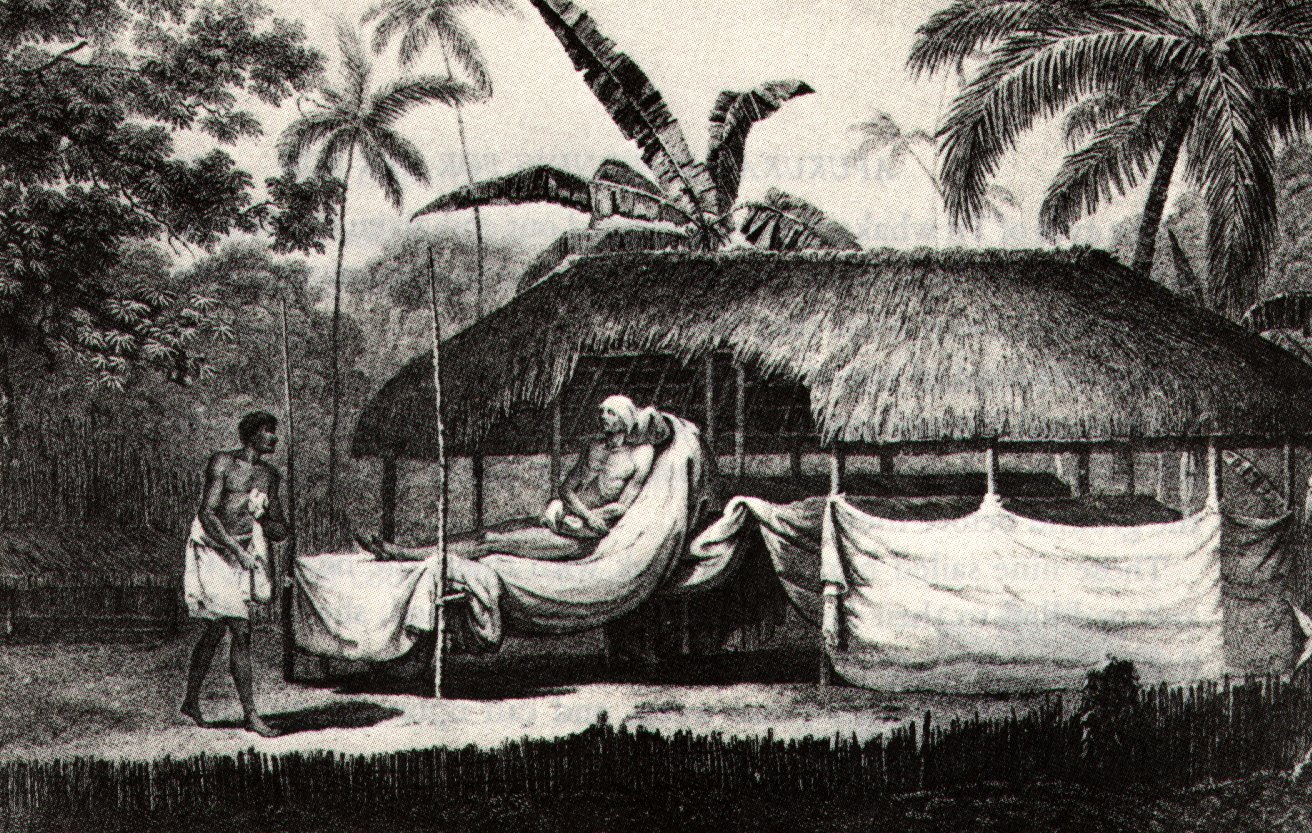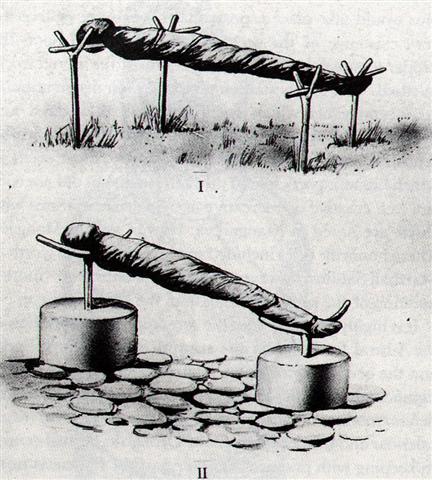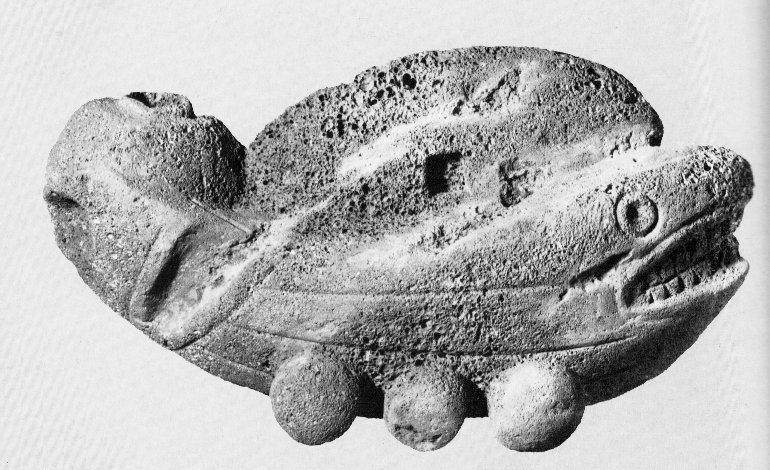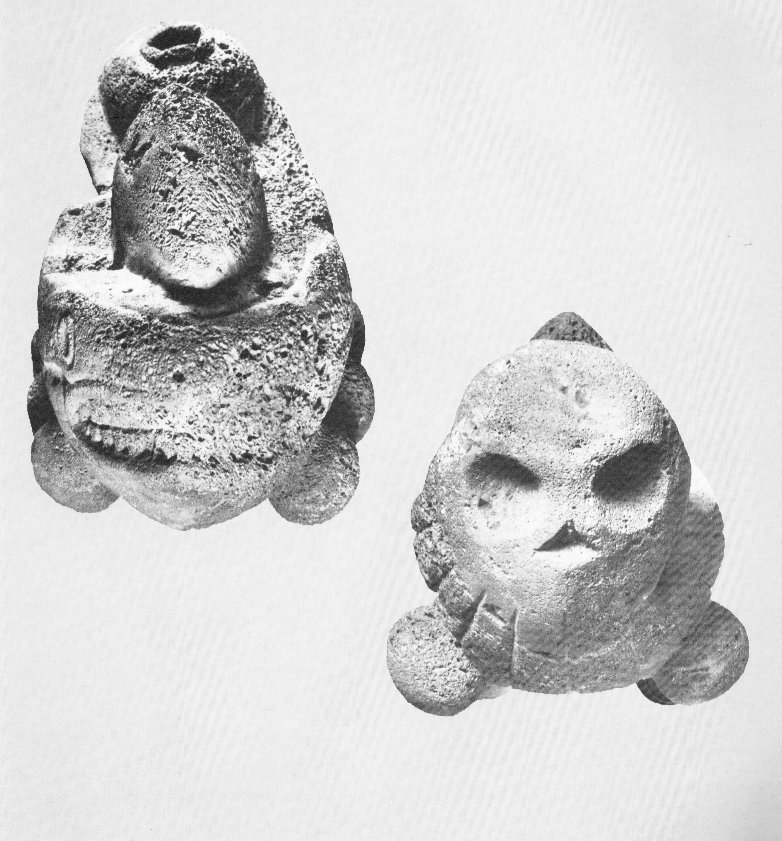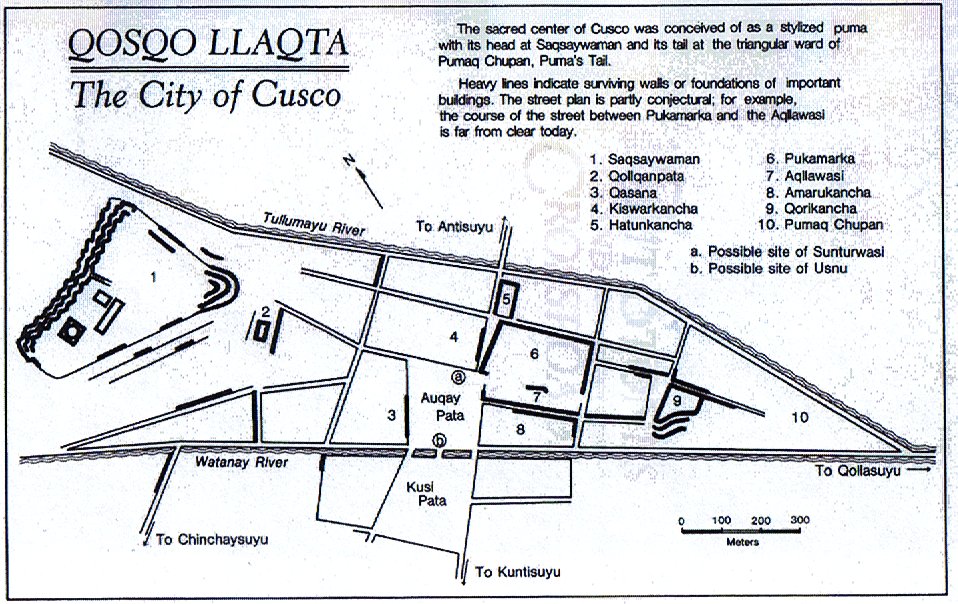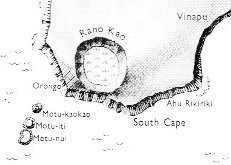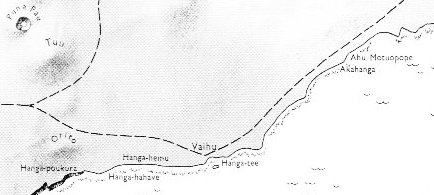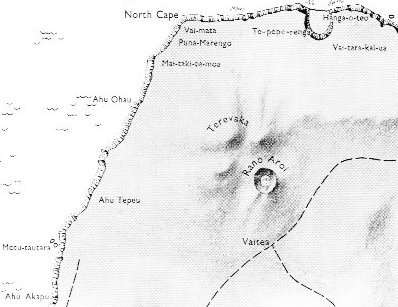|
TRANSLATIONS
Ha6-15 is the last wholly intact glyph in the day calendar of H. I therefore will not dive deep trying to analyse each of the glyphs above, and I have also included the very last ('10th') period here. The sun in Ha6-15 has no obvious marks and looks like an ordinary p.m. sun. Ha6-16 is the upper part of what Metoro usually read as toga, presumably the north 'pole' or wherever the winter sun goes. Ha6-17 is the upper part of a glyph which probably is identical in form with the 'parallel' glyphs in the three preceding periods. Ha6-18 is the upper part of tapa mea, possibly like the those in the two preceeding periods, possibly not. Ha6-19 has only one head, instead of the expected two. I guess that is due to the glyph being incomplete. Number two is, I believe, important in this location, where two ruling forces govern. If Ha6-19 has only one 'head', then perhaps the adjacent missing glyph has the other one? Double rule seems to be found not only at dawn and sundown but also at noon, sun is there both personified and seen as his ordinary self. At noon the rule of a.m. changes over to the rule of p.m. and as always with such 'relays' presumably with some overlapping:
Two empty spaces show where presumably originally there were two glyphs, judging primarily from the parallel texts in A and P. Barthel gives us this picture, which adds nothing definite about number of glyphs missing:
The number of glyphs in the total calendar (night + day + extra sequence) in H probably is 52 (= 364 / 7). Is that not a sign that we have been totally wrong, that what we are investigating here is not a calendar for the day but rather for summer? That is a good question. The similarities between the two sun 'circles' ('day' and year) are so many - as we have begun to realize - as to make it difficult indeed to decide whether what we are looking at really is a calendar for the day (and not for the summer). Furthermore, those extra glyphs seem inexplicable if we think of the 'day', whereas in the year we have those extra 'dark nights' (365 1/4 - 360). To take care of the last mentioned problem first: In Tahua those extra glyphs arrive immediately before the day calendar and that does not harmonize with a calendar for the year. Because the extra days ought to arrive in the middle of the 'night' (winter), not just before 'sunrise' (equinox). And in P and H the extra glyphs arrive immediately after the day calendar which is equally false as a representation of the extra 'dark nights' of the year. But what are those extra glyphs then? We should avoid that question until later, but I guess that they may give some general remarks about the play of light and darkness as an affect of the movements of the earth. Although year and 'day' are very similar in structure there are some differences. One is those 5 intercalated 'nights' in midwinter, which have no equivalence in the calendar for the 'day'. 24 hours cover the whole 'day'. Another difference is what happens around the 'equinoxes'. Although sun runs very fast at equinox time he does not suddenly appear / disappear as at dawn and at sundown. Compared to those dramatic events his movements are not so quick and fundamental. Sun does not 'die' at autumn equinox, does not leave us in total darkness. We cannot, though, be absolutely sure until much more of the rongorongo texts have been translated. Sometimes the 'map' in our minds is so strong that we cannot observe reality as it 'really' is: "Most published descriptions of Aagjuuk tend to leave the impression that it suddenly appears on cue as if out of nowhere... This definition is somewhat misleading because throughout the autumn and winter months at latitudes above the Arctic Circle Aagjuuk's principal star, Altair, is one of the brightest and most visible stars in the south and western sectors of the sky. But so completely is Aagjuuk identified with mid-December and the winter solstice that one Igloolik elder, invited to point to the constellation in early November, firmly replied that we would not see it until around Christmas, and this in spite of the fact that Altair was at the time in full view to the southwest." (Arctic Sky) We should 'reculer pour mieux sauter' as the French wisely say, return and look once more, thereby also learning more. |
|||||||||||||||||||||||||||||||||||||||||||||||||||||||||||||||||||||||||||||||||||||||||||||||||||||
|
Umu we should try to learn more about, a concept of 'central' importance. Let us use the rest of the commentaries about this day calendar for a preliminary investigation: "If the moral attitudes of primitive man are hard for the Western mind to grasp and translate into familiar terms, there can hardly be one more so than the Maori notion of cooked food as the lowest thing, the furthest opposite to the sacred, in fact filthy. For us to divest our minds of Christian notions of good and evil and substitute the concept of simple payment, harm for harm (or 'revenge', as we commonly call it with a misleading moral overtone), is simple enough - perhaps because every schoolchild has at some time known the latter in his horrid heart. Even the Maori custom of weeping over friends when they arrive instead of when they depart has a certain logic that is not beyond our comprehension. But to enter, against all conditioning, into the minds of a people for whom cooked food and the act of eating could carry the overtones of meaning that we in our greater wisdom attach to their physical opposites and to sex, is a good deal harder. One has somehow to throw the mind into a state of being that is radically unlike ours. Yet if the trick can be done, a light comes on." (Maori Myths) Instead of being cooked in the earth oven men maybe should be fried in the sun: "Polynesian culture as encountered by the early Europeans was based on a few and rather simple culture elements following them about everywhere: the neolithic elbow adze, the dugout canoe, the specialized types of fishhooks, the bark beater, the poi pounder, the earth oven, and the kava drinking ceremonies. Since these traits are practically pan-Polynesian they must have been present already in the outside area from which the tribal ancestors spread all over the vast Polynesian triangle." "There is no need to go into detail regarding the further creeds and customs [in addition to the belief in Kane / Tane] in which various Maori-Polynesian tribes follow the pattern of their Northwest Coast neighbors, such as nose rubbing as a salute, topknots as masculine coiffure, feathers of big birds as hair decoration, head flattening, body tattooing, finger severance, fire walking, armor for combat, the tongue as a symbol of defiance, and weapons carved as stylized heads with an outstretched tongue as the blade, the ignorance of stringed musical instruments which had their main world center between India and Indonesia, and a Maori repetition of the Northwest Coast rattles, percussion instruments, and the wooden flute or flageolet carved as a grotesque human face with sound issuing from its wideopen mouth, the system of taboo, the dread of burial in the ground and preference in both areas of placing the dead on wooden platforms raised on poles, the dried-up remains or skeletons wrapped in bark blankets and deposited in a sitting position with knees below chin in caves, trees, or (also in both areas) in part of a canoe." "The pan-Polynesian use of the earth oven was in turn linked with their surprising ignorance of pottery. Wheeled pottery was known thoughout Southeast Asia, including Indonesia, and coiled pottery in most of America and Melanesia since very early neolithic times. The first settlers of Polynesia must at one time have been familiar with the art of pottery making, for shards of coiled pottery have been found archaelogically both in the eastern and western extremities of Polynesian territory. However, the fact that historic and protohistoric tribes on every island in Polynesia were totally ignorant of ceramic art and for boiling in pots substituted baking in special stone-lined earth ovens is so remarkable that it requires explanation, since there is no lack of suitable clay that could have been used for pottery making. Again, in marked contrast to all other circum-Pacific peoples except the primitives of Tierra del Fuego, the maritime tribes of the Northwest Coast were all as ignorant of pottery as were the Polynesians. They, too, baked their food in the very same kind of stone-lined earth oven until Europeans arrived. Among those who first saw the significance of this remarkable geographical distribution was the intrepid traveler J. Macmillan Brown, who wrote of the earth oven: 'it is one of the most distinctive marks of the culture of the Polynesians and went with them wherever they went. It was probably bred in the frozen soil of the wintry north, and belonging to the natives of the northwest coast of America, as it does, it is one of the clues that seem to indicate affinity between them and the Polynesians..." (Heyerdahl 2) Old men should end their days by being put on a platform to dry out their bodies totally, the process of d(r)ying having started already at noon, '.... the dread of burial in the ground and preference in both areas of placing the dead on wooden platforms raised on poles, the dried-up remains or skeletons wrapped in bark blankets and deposited in a sitting position with knees below chin in caves, trees, or (also in both areas) in part of a canoe ...'
(The picture is from Legends of the South Seas and shows 'the embalmed body of Ti'i, a Tahitian chief'.) "As its end approached the phoenix fashioned a nest of aromatic boughs and spices, set it on fire, and was consumed in the flames. From the pyre miraculously sprang a new phoenix, which, after embalming its father's ashes in an egg of myrrh, flew with the ashes to Heliopolis where it deposited them on the altar in the temple of the sun god Ra ..." (Hancock 3)
"What is the significance of the Y-motif? What in Polynesian material culture may have inspired it? 'Fork shaped' implements, sticks and posts were widely utilised in Oceania for a variety of construction, fishing and other tasks. Y-shaped posts framed houses and were the supports for funeral biers on many islands, including Rapa Nui." (Van Tilburg) Before embalming the corpse of a chief it is necessary to remove its fluids: "Embalming is known and practised with surprising skill in one particular family of chiefs. Unlike the Egyptian method, as described by Herodotus, it is performed in Samoa exclusively by women. The viscera being removed and buried, they, day after day, anoint the body with a mixture of oil and aromatic juices. To let the fluids escape, they continue to puncture the body all over with fine needles. In about two months, the process of desiccation is completed. The hair, which had been cut and laid aside at the commencement of the operation, is now glued carefully on to the scalp by a resin from the bush. The abdomen is filled up with folds of native cloth; the body is wrapped up with folds of the same material, and laid out on a mat, leaving the hands, face, and head exposed." (Turner and Stair according to Bierbach) Instead of the sun going down into the watery underworld and there being dissolved like in a cooking pot great efforts are made by the women to have him preserved in form so that it will be possible to restore him in the 'morning'. "...the Hawaiian staple, taro, is the older brother of mankind, as indeed all useful plants and animals are immanent forms of the divine ancestors - so many kino lau or 'myriad bodies' of the gods. Moreover, to make root crops accessible to man by cooking is precisely to destroy what is divine in them: their autonomous power, in the raw state, to reproduce." (Islands of History) Not cook but to prick with needle, that is the message we now have learnt. Recall with this in mind e.g. these glyphs:
They possibly have, as I believe, signs of thorns or spikes or something like that. Notice that they are located at or close to noon (left) alternatively at or close to sundown (right). Star lore give us further evidence of 'noon' and 'sundown' as times of 'spikes' or at least of 'instruments of death' (e.g. the scythe). "The Egyptian king Necepsos, and his philosopher Petosiris, taught that at the Creation the sun rose here near Denebola [the tail of Leo]; and hence Leo was Domicilium Solis, the emblem of fire and heat, and in astrology, the House of the Sun, governing the human heart ..." "Ancient physicians thought that when the sun was in this sign [Leo] medicine was a poison, and even a bath equally harmful ..." "Its drawing has generally been in a standing position, but, in the Leyden Manuscript, in a springing attitude, with the characteristic Sickle fairly represented." "These same Sickle stars were a lunar mansion with the Akkadians as Gis-mes, the Curved Weapon; with the Khorasmians and Sogdians as Khamahish, the Scimetar; but with the Copts as Titefui, the Forehead." (Allen) Such a word as Corleone now takes on a new meaning. And we have indeed located the sacred jawbone correctly at noon. And a bath certainly is harmful for a dead chief. And then we have Spica (the Spike): "Spica signifies, and marks, the Ear of Wheat shown in the Virgin's left hand ..." "In Chinese astronomy Spica was a great favorite as Kió, the Horn, or Spike, anciently Keok or Guik, the special star of springtime; and with ζ formed their 12th sieu under that title." "It was to the observations of this star and of Regulus [α Leo] about 300 BC, recorded by the Alexandrian Timochares, that, after comparison with his own 150 year later, Hipparchos was indebted for the great discovery attributed to him of the precession of the equinoxes; although Babylonian records, and the temple orientations of Egypt and Greece, may indicate a far earlier practical knowledge of this." (Allen) The lion symbolizes the sun in its 'noon' appearance, the time when it is hot. Fire in an earth oven is also hot. Sun and fire are equivalent. "The adoption of this animal's form for a zodiac sign has fancifully been attributed to the fact that when the sun was among its stars in midsummer the lions of the desert left their accustomed haunts for the banks of the Nile, where they could find relief from the heat in the waters of the inundation; and Pliny is authority for the statement that the Egyptians worshiped the stars of Leo because the rise of their great river was coincident with the sun's entrance among them. For the same reason the great Androsphinx is said to have been scultured with Leo's body and the head of the adjancent Virgo ..." (Allen) There is a belt of sun-worshipers around the equator and e.g. Singapore means the city of the lion. But there are no lions on Easter Islands. Or?
Postponing the answer to that question for the moment I suggest that we first take a look at the tail of this 'sun-fish', because there we find an umu: "The image is that of a reed boat with a whale's or sea monster's head at the bow, and a skull-like mask at the stern. At the top of the stern is a five-sided umu, or Easter Island fireplace, and on deck is a hare paenga, or lenticular reed house, with a square doorway on the starboard side. On the same side, a wide channel surrounded by a V-shaped groove leads down from the deck aft." (Heyerdahl 3) The 5-sided earth oven is seen more clearly on the picture below (at left where the view is from the front). At right we see the tail end.
The tail end (right) is like death and therefore illustrated by a cranium. The front end (left) shows the grin like that of a voracious a.m. (or equinox) sun. From the grin and backwards we recognize the path of the sun, henua, broken off by another henua formed like the upper half of Y (or like haga). The two eyes - one on each side - are incised as sun-symbols. The two sides may represent halfyears. The six 'balls' on which the 'boat' is rolling along represent the six double-months in a year, three on each side (half-year). Or they could represent the six double-hours of the day (of light). With umu on top of the tail we can draw the conclusion that the time of cooking in the oven should be close to the end of the season. Maybe the standard number 5 for the sides of the oven indicates the 5 extracalendrical days in the year? A new fire must be started at that time because a new year should be ignited. In South America there are no lions and the closest animal in the family is the jaguar. But he prowls in the night and cannot be the symbol for the noon sun. Furthermore: "It is strongly associated with the presence of water and is notable, along with the tiger, as a feline that enjoys swimming." (Wikipedia. Internet) Another - more promising cat - is the puma.
"The principal attribute of the signs 'Puma' and 'Wari-Willka' is the sign 'Star' representing, when it is the depiction of 'Puma' the moon, and when it is 'Wari-Willka' the sun. Due to this circumstance and many other peculiar things which have been observed ... it is correct to assert that the Tihuanacuans held the belief that a feline (Puma), who lived in the center of the earth swallowed the moon. Indeed its last quarter was the same as the form of the jaws of a beast of prey which had sunk his teeth in it, a belief quite explainable in peoples with a relatively limited degree of culture. The last quarter probably represented the moon after it had been eaten by the supposed animal, and the first quarter, the growth of the moon while the animal, replete with the first bite, left it in peace." "... can be seen two different animals together, and on the edge of the piece of ceramic work a beast of prey (Puma) is seen with a yellow disc hanging from its neck - the moon; and lower down a fissiped (Wari-Willka) with a white disc - the sun." (Posnansky) The jaguar on the other hand does not take just a little bite: "The jaguar has developed an exceptionally powerful bite, even relative to the other big cats. This allows it to pierce the shells of armoured reptiles and to employ an unusual killing method with mammals: it bites directly through the skull of prey between the ears to deliver a fatal blow to the brain." (Wikipedia. Internet) I wonder if the jaguar could crack a coco-nut? "High overhead circle the menacing, effortless shapes of hawks, occasionally one drops suddenly on a kill. I have been told that the name of the hill comes from these birds, that it means Hawk, Eat Your Fill, from waman, 'hawk' and the verb saqsay, 'to be sated'. But there's an archaic word saqsa, meaning 'royal'; Royal Hawk is probably a better translation. The name, however, has very little to do with the physical presence of raptorial birds. In the scheme of Cusco, Saqsaywaman represents the puma's head; the zigzag ramparts are the big cat's jaws. Why then is the hill not called Puma's Head? The puma, a creature of the earth and night, is lower moiety. He therefore cannot represent something that is whole; to do this a composite being must be called into existence - the 'bird-feline', a figure that first appears in Peruvian iconography on the carvings of Chavin. Waman, the hawk, is of the day and air, hence upper moiety. It is therefore fitting that the highest part of Cusco should include the name Waman, and there are those who go so far as to suggest that the zigzag walls represent not only a puma's fangs, but also the tail markings of the hawk.
There's an interesting footnote to all this: though he does not say so, it seems that the writer Felipe Waman Puma assumed the same combination of names for the same reason - to express symbolically that in his plea to the king [of Spain] he was representing the people of Tawantinsuyu as a whole." (The Two Worlds of Peru) If we reflect on the puma as an animal which corresponds to the lion of 'noon', we should recognize that at that time south of the equator it is 'midnight' - at least if we think about the year. How nice then that the puma is an animal of the moon. Moon is the inversion of sun. But wouldn't the jaguar have been a better choice than the puma? No, the coast of Peru is like a stony desert, not the place for a jaguar. (Ref. Wikipedia)
I have now established a plausible link between the Egyptian sun-lion and the Peruvian (and also the Tiahuanacian) moon-puma. Next step should now be a jump from South America over to Easter Island. Thinking about that we could reason like this: Easter Island is south of the equator. If they followed the lead from South America that means we should search not for a lion but for a creature of the moon. Leo has now moved from spring equinox to autumn equinox, half the precessional circle as counted from 10,500 BC. If we are standing on Easter Island and searching for Leo in the sky, we could look towards east in the early dawn - given that we timed this search to the end of September. But at that time it is not autumn equinox but spring equinox (south of the equator). It would be similar to 10,500 BC in Egypt. However, the puma tells us that this must be wrong. Autumn equinox it should be, not spring equinox. Because the moon (puma, darkness) should rule, not the sun (lion, light). OK. Then we watch for Leo (thinking of it as the Puma) and we will do it at autumn equinox (i.e. at the end of March). Where shall we look? We must look towards west and do it in the evening just after the sun has gone down. Crossing the equator changes everything and we are left in uncertainty. Barthel has the solutions (though I doubt whether he ever formulated the problems we just have been trying to define). The following is his translations of The Dream Voyage of Hau Maka (according to Manuscript E, pp. 6-13 - ref. Barthel 2). The maps are my cuts from Heyerdahl 4. Commentaries of differents kinds are inserted at the relevant locations in the text and the quotations are all from Barthel 2 - unless otherwise indicated. My own comments have no quotation marks. "Hau Maka had a dream. The dream soul of Hau Maka moved in the direction of the sun (i.e., toward the East). When, through the power of her mana, the dream soul had reached seven lands, she rested there and looked around carefully. The dream soul of Hau Maka said the following: 'As yet, the land that stays in the dim twilight during the fast journey has not been reached.' The dream soul of Hau Maka countinued her journey and, thanks to her mana, reached another land. She descended on one of the small islets (off) the coast). The dream soul of Hau Maka looked around and said: 'These are his three young men.' She named the three islets 'the handsome youths of Te Taanga, who are standing in the water' [1 Nga Kope Ririva Tutuu Vai A Te Taanga].
The dream soul of Hau Maka continued her journey and went ashore on the (actual Easter) Island. The dream soul saw the fish Mahore, who was in a (water) hole to spawn (?), and she named the place 'Pu Mahore A Hau Maka O Hiva' [2 Te Pu Mahore]. The dream soul climbed up and reached the rim of the crater. As soon as the dream soul looked into the crater, she felt a gentle breeze coming toward her. She named the place 'Poko Uri A Hau Maka O Hiva' [3 Te Poko Uri]. The dream soul continued her search for a residence for King Matua. The dream soul of Hau Maka reached (the smaller crater) Manavai and named the place 'Te Manavai A Hau Maka O Hiva' [4 Te Manavai]. The dream soul went on and reached Te Kiore Uri. She named the place 'Te Kiore Uri A Hau Maka O Hiva' [5 Te Kioe Uri]. "The dream soul of Hau Maka gave names to many places on Easter Island, all with the addition 'belonging to (a) Hau Maka from (o) Hiva'. In all, there are twenty-eight names ... I 'translate' 28 as the number of nights in a month when the moon may be visible. That the dream soul is female also indicates that presumably the journey is a moon journey. However, as will be clear later, the counterclockwise journey is a solar journey. Therefore 28 = 24 + 4 and those 24 are the number of half-months in a year, while 4 should be the four quarter pillars. The moon (dream soul) makes a 'reconnaissance' visit to Easter Island. The starting point of all lists of names, attributed directly or indirectly to Hau Maka, are the three islets off the southwestern cape of Easter Island; this is traditionally the place where Hotu Matua later arrives in his double canoe. Historically, the channel between Orongo and Motu Nui was the center of the cult of the birdman, and the annual race from Orongo to Motu Nui was the high point in the life of the Easter Islanders during pre-missionary times. From there, the path of the dream soul leads to the cliffs below the lowest edge of the rim of the crater Te Karikari, reaches Rano Kau, which is given the name 'dark abyss' (poko uri), passes the side crater Manavai and the place of the 'dark rat' (kioe uri) in the hinterland of Vinapu, and finally follows the whole southeastern shoreline." The dream soul went on and came to Te Piringa Aniva. She named the place 'Te Piringa Aniva A Hau Maka O Hiva' [6 Te Piringa Aniva]. Again the dream soul went on her way and reached Te Pei. She named the place 'Te Pei A Hau Maka O Hiva' [7 Te Pei]. The dream soul went on and came to Te Pou. She named the place 'Te Pou A Hau Maka O Hiva' [8 Te Pou]. The dream soul went on and came to Hua Reva. She named the place 'Hua Reva A Hau Maka O Hiva' [9 Hua Reva]. The dream soul went on and came to Akahanga. She named the place 'Akahanga A Hau Maka O Hiva' [10 Akahanga]. "With the aid of my key informant, I was also able to chart the less well known places. The dream soul names 'Te Piringa Aniva', east of Hanga Pau Kura, 'Te Pei', a few hundred meters farther on and across from Motu Roa, and 'Te Pou', east of Vaihu. The names 'Huareva' and 'Akahanga' are well known and are used in two recitations (Barthel 1960:843 f and g; Campbell 1971:411)."
The dream soul went on. She was careless (?) and broke the kohe plant with her feet. She named the place 'Hatinga Te Koe A Hau Maka O Hiva' [11 Hatinga Te Kohe]. The dream soul went on and came to Roto Ire Are. She gave the name 'Roto Ire Are A Hau Maka O Hiva' [12 Roto Ire Are]. The dream soul went on and came to Tama. She named the place 'Tama' [13 Tama], an evil fish (he ika kino) with a very long nose (he ihu roroa). "From this point the distances become greater. It takes nearly an hour on foot to reach Hatinga Te Kohe (near Ahu Mahanga, south of Cerro Toatoa) from Akahanga. The name 'Breaking of the kohe plant', which is used in the same or nearly the same form in all of the tradition, must refer to a special event. *Kofe is the name for bamboo on most Polynesian islands, but today on Easter Island kohe is the name of a fern that grows near the beach. Roto Ire Are is an adjacent cape to the south; it is also the name for the fishing grounds off the cape. Further to the east, there is Tama, whose addition 'an evil fish with a long nose' is explained by Juan Tepano to mean 'a shark' (he niuhi ME:58) and may be connected with the youngest son of Hotu Matua (TP:54)."
Obviously we have at Hatinga Te Kohe what Metoro usually called 'koti koti' and what I believe is meant to signify the end of a period (and the beginning of a new one). That fits in very well with pieces of bamboo as symbols for 'seasons' of time (henua). As Hatinga Te Kohe is no. 11 of 24 stations (excluding those extra 4), the meaning might have something to do with 'half-way station' of the journey. The numbers are related to the solar calendar for the year. No. 13 (the evil fish with a very long snout), must have a similar meaning. The 'very long snout' ought to be a 'pole' where directions must change and therefore one rule must be broken in order to introduce a new 'henua'. Notice also that for once the wording 'A Hau Maka O Hiva' is not used, there is nothing to 'own' (rule) - it is just a 'point' without extension. This fits in with Barthel's ideas about how the four sons of Hotu Matua each one is 'ruler' of a separate part of the (is)land. The youngest son is like a great shark, according to the last words of Hotu Matua on his deathbed: "The fourth child entered. Matua kissed him on both cheeks and asked, 'Who are you?' He answered, 'It is I, the last-born (hangu potu), Te Mata O Tuu Hotu Iti.' The king was glad and said, 'You are a very strong child (poki hiohio), oh last-born, I wish you luck! Swift (?) is the great shark of Motu Toremo Hiva, of the homeland!' That was the end of King Hotu A Matua's speech to his children." No. 12 (= 24 / 2), Roto Ire Are, therefore is flanked by two signs marking a cardinal point. And Roto Ire Are is a 'cape to the south'.
The dream soul went on and came to One Tea. She named the place 'One Tea A Hau Maka O Hiva' [14 One Tea]. She went on and reached Hanga Takaure. She named the place 'Hanga Takaure A Hau Maka O Hiva' [15 Hanga Takaure]. The dream soul moved upward and came to (the elevation) of Poike. She named the place 'Poike A Hau Maka O Hiva' [16 Poike]. The dream soul continued to ascend and came to the top of the mountain, to Pua Katiki. She named the place 'Pua Katiki A Hau Maka O Hiva' [17 (Maunga) Pua Katiki].
"The dream soul passes the 'white sand' (one tea) without paying attention to the crater and quarry of Rano Raraku, of outstanding importance in the history of Easter Island. Then the dream soul passes the 'bay of flies' (hanga takaura), east of Hanga Nui, and climbs up to the barren height of Poike (compare MAO. poike 'place aloft') with the summits Pua Katiki and the 'white mountain' (maunga teatea). The latter is a side crater in the northern flank of Poike." "From a religious point of view, the high regard for flies, whose increase or reduction causes a similar increase or reduction in the size of the human population, is interesting, even more so because swarms of flies are often a real nuisance on Easter Island, something most visitors have commented on in vivid language. The explanation seems to be that there is a parallel relationship between flies and human souls, in this case, the souls of the unborn. There is a widespread belief throughout Polynesia that insects are the embodiment of numinous beings, such as gods or the spirits of the dead, and this concept extends into Southeast Asia, where insects are seen as the embodiment of the soul."
Everywhere the dream soul looked around for a residence for the king. The dream soul went to Maunga Teatea and gave him the name 'Maunga Teatea A Hau Maka O Hiva' [18 Maunga Teatea]. The dream soul of Hau Maka looked around. From Maunga Teatea she looked to Rangi Meamea (i.e., Ovahe).
The dream soul spoke the following: 'There it is - ho! - the place - ho! - for the king - ho! - to live (there in the future), for this is (indeed) Rangi Meamea.' The dream soul is female and the mountain is male, clearly as you dream in the night and as the mountain is closer to the sky than the the plain earth. The word teatea not only means white but haughty. The word katiki means 'halo (of sun, of moon)'. The crater rim of Maunga Pua Katiki may be regarded as a kind of 'halo'.
Obviously there are two contrasting colours here, teatea and meamea, presumably expressing 'moon' and 'sun' (similar to hau tea followed by tapa mea in the day calendar). Craters symbolize the female, while peaks symbolize the male. The dream soul descended and came to Mahatua. She named the place 'Mahatua A Hau Maka O Hiva' [19 Mahatua]. The dream soul continued to look around for a residence for the king. Having reached Taharoa she named the place 'Taharoa A Hau Maka O Hiva' [20 Taharoa]. The dream soul moved along and reached Hanga Hoonu. She named the place 'Hanga Hoonu A Hau Maka O Hiva' [21 Hanga Hoonu]. "Poike is the turning point of the journey. After heading west, the explorers [?] survey the northern shore as a residence for the king. Well-known places along this shore, such as Mahatua, Taharoa, and the 'bay of turtles' are rejected. Not until the dream soul reaches the 'reddish sky' (rangi meamea), which is today called Ovahe, does the land become suitable for settlement. The main requirement are level land and a safe place for the canoes to land (maara, HM:465). Protected by the heights of Peke Tau O Hiti, today called Cerro Puharoa, and Hau Epe (see NA I:277), the final goal of the dream voyage turns out to be the best landing site and the finest beach on Easter Island. Oromanga is the eastern part of the beach of Anakena; the bay of Moria One is the western part." "The names of the pair of mountains, 17 and 18, imply color substances ('yellow root' pua renga and 'chalk white' teatea), while their topographical features suggest the contrast of crater and cone-shaped hill. Pair 19 and 20 has directions contained in its names ('backside' tua and 'flank' taha). Pair 21 and 22 leads one to think of the contrast between 'depth' (wordplay on hohonu) and 'height' ('sky' rangi). Thus, both of the pairs of east-west direction have directional characteristics." Mahaga = baby when able to stand by itself (Vanaga), points to the possibility of 'noon' (a standing person) just has passed (i.e. is now at the backside). I therefore think that the contrast (in pair 19 and 20) more is a question of mahatua = the 'noon' has just passed away and taharoa = the long 'descending'.
The dream soul came to Rangi Meamea and looked around searchingly. The dream soul spoke: 'Here at last is level land where the king can live.' She named the place 'Rangi Meamea A Hau Maka O Hiva' [22 Rangi Meamea]. The mountain she named 'Peke Tau O Hiti A Hau Maka O Hiva' [23 (Maunga) Peke Tau O Hiti]. The dream soul moved along a curve from Peke Tau O Hiti to the mountain Hau Epa, which she named 'Maunga Hau Epa A Hau Maka O Hiva' [24 Maunga Hau Epa]. "It is difficult to interpret pair 23 and 24, which represents two mountains. The terracing of Maunga Hau Epa (this is the correct form, not 'Auhepa') and obscure traditions (RM:295; Brown 1924:59, Maunga Hau Eepe) suggest that the place must have had special importance." "The segment peke of place name 23 suggests (by way of MAO.) some type of insect (for example, pepeke 'insect, beetle'; pekeriki' 'lice, vermin'; peketua 'centipede')."
The dream soul went to the other side of the mountain Hau Epa. As soon as the dream soul looked around, she saw the sand (beach), which was very white and light. She remained there and explored everything. After she had looked around carefully, the dream soul of Hau Maka said, 'Ah! This is the place that will serve as a residence for the king. She named the place 'Oromanga A Hau Maka O Hiva' [25 Oromanga] and also named the neighboring bay 'Hanga Moria One A Hau Maka O Hiva' [26 Hanga Moria One].
"Loosely translated , the name [Hanga Moria One] means 'bay of pebbles', but it can also be translated as the 'wish for the protection of the land' (compare MAO. ria 'screening, protecting'; HAW. one poetic name for 'land'). It may be directly related to PPN. *mori 'offer, offering, act of worship, remove tapu'; HAW. molia 'to set apart for the gods; to sacrifice or offer to the gods, to bless, etc.'; and HAW. molia one 'sacrifice and prayer for the land'." The dream soul stepped forth lightly and reached Papa O Pea. She carefully looked around for a place where the king could settle down after his arrival and gather his people around (? hakaheuru). Having assembled his people (?) and having come down, he would then go from Oromanga to Papa O Pea, so went the speech of the dream soul. She named the place 'Papa O Pea A Hau Maka O Hiva' [27 Papa O Pea]. She then hastened her steps toward Ahu Akapu. There she looked again for a residence of the king. Again the dream soul of Hau Maka spoke: 'May the king assemble his people (?) and may he come in the midst of his people from Oromanga to Papa O Pea. When the king of Papa O Pea has assembled his people (?) and has come to this place, he reaches Aha Akapu. To stay there, to remain (for the rest of his life) at Ahu Akapu, the king will abdicate (?) as soon as he has become an old man'. She named the place 'Ahu Akapu A Hau Maka O Hiva' [28 Ahu Akapu]. The (entire) land she named 'Te Pito O Te Kainga A Hau Maka O Hiva'. The dream soul turned around and hurried back to Hiva, to its (Home)land, to Maori. She slipped into the (sleeping) body of Hau Maka, and the body of Hau Maka awakened. He arouse and said full of amazement 'Ah' and thought about the dream ..." The story then continues with how Hau Maka told his brother Hua Tava about the dream and how also the king (Hout Matua) was informed, and that the king then decided to make an expedition to the island with the explorers being the two sons of Hau Maka and the five sons of Hua Tava. For the present purposes that part of the story is not necessary. "While the dream soul seems to be conducting an inventory of two-thirds of the shoreline, which refers to the terrain and the existence of plants and animals, she moves on to an anticipated 'political level' once the future residence of the king has been located on the bay of Anakena. The last third of the shore of Easter Island, the future home of the aristocratic Miru tribe and of the western federation Ko Tu'u, who grouped themselves around the Miru, is no longer surveyed and named one place at a time. Only two localities are mentioned: Papa O Pea and Ahu Akapu. Métraux received the following information about the first place: '... the young princes were raised in a village Papa-o-pea, near Ahu Ohau, not far from Ahu-te-peu' (ME:132). About the second place he writes in a different context: 'According to a tradition which I was unable to check, each new king went to live at Ahu-a-kapu, near Tahai on the west coast. Later when he had yielded his authority to his son, he went to ahu Tahai and then to Anakena where he spent his last years' (ME:132).
Our sources show that Ahu Akapu [sic!] was the residence of the abdicated king. The area around Papa O Pea is substantiated in another context as the residence of the future king (Barthel 1963:412; Lavachery 1935:101-102), while all the available information points to Anakena as the residence of the ruling king of the island. The dream soul, therefore, is seeking out those three places of Miru territory where traditionally the king resided before, during, and after his reign. In connection with these three places, the king performs a task called hakaheuru (literally, 'making something come about'). In RAP. this means 'to mingle', and the action has to be related to the office of the king. Based on MAO. whakaauru 'to ally oneself to, to join', I thought of the assembling of the followers, as one would expect for the installation of the king or his moving to a new residence." Now, where does all this lead us? My primary idea was to make it, if not probable, at least possible, that the Black Rat (Kiore Uri) is equivalent to Leo, or to the stars of Leo. There are no pumas on Easter Island and therefore we must pick a rat as the symbol of the big cat. Quite am(o)using. South of the equator the midsummer appearance of Leo must be inverted into a midwinter appearance. Given that we can 'map' the voyage of the dream soul of Hau Maka as the yearly voyage of the sun, we then can check the guess about Kiore Uri = Leo. Barthel has given us the following data:
The twelve Rapanui months are divided into half-months according to the numbers, which refer to the order established by the voyage of the dream soul:
"The triple division of the Marquesan year yields the segments August-November, December-March, and April-July (Handy 1923:346)." "The months were also personified by the Marquesans who claimed, as did the Moriori, that they were descendants of the Sky-father. Vatea, the Marquesan Sky-parent, became the father of the twelve months by three wives among whom they were evenly divided. (Makemson 1941:103; italics mine)" "A curious diversion appears in the month list of the people of Porapora and Moorea in the Society Islands, which sheds light on the custom of the Moriori who sometimes placed 24 figures in the canoe which they dispatched seaward to the god Rongo on new years day. The names of the wives of the months are included, indicating that other Polynesians besides the Chatham Islanders personified the months. (Makemson 1941:102; list of months after Henry 1928; italics mine)." Te Kio(r)e Uri is no. 5, which means that he is located in Maro (June), the winter solstice month. I would not be astonished if the Chinese Kió, the Horn, or Spike, as a name for Spica, had something to do with the Easter Island Kio(r)e. The spelling of kiore may also be kio'e (= kioe).
As regards umu, it is now quite clear that the Black Rat cannot be umu south of the equator. Searching along the voyage of the dream soul we instead find at summer solstice no. 17 (= 5 + 12) as Pua Katiki. We may rather confidently define Pua Katiki = umu. The fiery crater of a volcano certainly is qualified as a hot place and as the crater is located in the earth the similarity with the earth oven is obvious. When Metoro used the word nuahine at noon I think he thought about the hot oven of that old lady, i.e. about not only nuahine as such but also - and foremost - about her umu. At noon the now fully grown sun encounters the female umu. There remains one question: What stars in the sky are equivalent to Umu? 180o away from Leo we find Aquarius - quite in order as that constellation once was just a jar: "Wassermann - Amphora Davon findet sich in den veröffentlichen Texten, soweit ich sehe, keine Spur. Da derselbe aber einen der Ía- bez. Wassergegend des Himmels entsprechenden Namen hat, kann die Idee dieses Sternbildes, wenn auch nich alt-babylonisch, so doch vielleicht neu-chaldäisch sein. Nach den Benennungen der Orientalen zu schliessen dürften wir am chaldäischen Himmelsglobus nicht nach einem 'Wassermann', sondern nur nach einer Amphora suchen. Der Wassermann ist occidentalischen Ursprungs." (Jensen) The Easter Islanders seem to have done just as we do in astrology - locked the constellations as they once upon a time were seen. Leo is no longer in zenith at midsummer noon and the Amphora is no longer in the deep water; the constellations have moved 90o since then (= approximately 6,500 years ago). Whether the old Babylonian umu really is the same word as the Polynesian umu is of no importance - it has fulfilled its role as a guide. |





